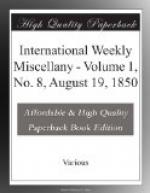Before the day’s work was ended, however, little Jem again had a glimpse of the prize which had escaped him on the previous occasion. He instantly darted, hands and head foremost, into the mass of cinders and rubbish, and brought up a black mass of half-burnt parchment, entwined with vegetable refuse, from which he speedily disengaged an oval frame of gold, containing a miniature, still protected by its glass, but half covered with mildew from the damp. He was in ecstacies at the prize. Even the white catskins paled before it. In all probability some of the men would have taken it from him, “to try and find the owner,” but for the presence and interference of his friends Peg Dotting and old Doubleyear, whose great age, even among the present company, gave them a certain position of respect and consideration. So all the rest now went their way, leaving the three to examine and speculate on the prize.
These Dust-heaps are a wonderful compound of things. A banker’s cheque for a considerable sum was found in one of them. It was on Merries & Farquhar, in 1847. But bankers’ cheques, or gold and silver articles, are the least valuable of their ingredients. Among other things, a variety of useful chemicals are extracted. Their chief value, however, is for the making of bricks. The fine cinder-dust and ashes are used in the clay of the bricks, both for the red and gray stacks. Ashes are also used as fuel between the layers of the clump of bricks, which could not be burned in that position without them. The ashes burn away, and keep the bricks open. Enormous quantities are used. In the brickfields at Uxbridge, near the Drayton Station, one of the brickmakers alone will frequently contract for fifteen or sixteen thousand chaldrons of this cinder-dust, in one order. Fine coke, or coke-dust, affects the market at times as a rival; but fine coal, or coal-dust, never, because it would spoil the bricks.
As one of the heroes of our tale had been originally—before his promotion—a chimney-sweeper, it may be only appropriate to offer a passing word on the genial subject of soot. Without speculating on its origin and parentage, whether derived from the cooking of a Christmas-dinner, or the production of the beautiful colors and odors of exotic plants in a conservatory, it can briefly be shown to possess many qualities both useful and ornamental.
When soot is first collected, it is called “rough soot”, which, being sifted, is then called “fine soot”, and is sold to farmers for manuring and preserving wheat and turnips. This is more especially used in Herefordshire, Bedfordshire, Essex, &c. It is rather a costly article, being fivepence per bushel. One contractor sells annually as much as three thousand bushels; and he gives it as his opinion, that there must be at least one hundred and fifty times this quantity (four hundred and fifty thousand bushels per annum) sold in London. Farmer Smutwise, of Bradford, distinctly asserts that the price of the




